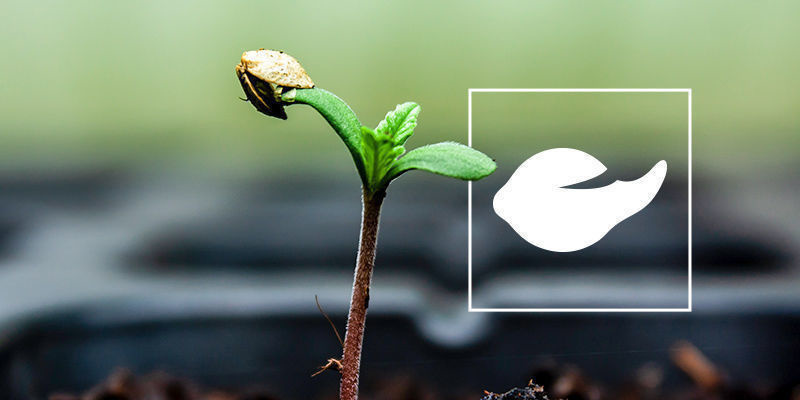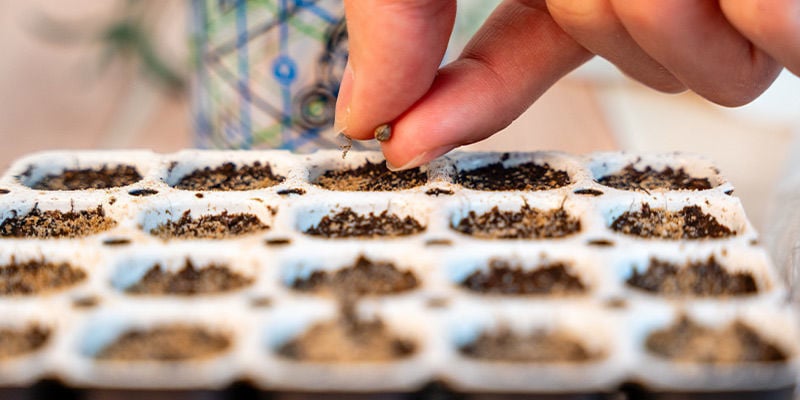How To Germinate Cannabis Seeds

Cannabis seed germination needn't be a stressful affair. Consult this guide to familiarise yourself with the different germination methods available, so you can see which one is best for you. Plus, learn how to get old cannabis seeds to sprout and grow into healthy specimens.
There are thousands of cannabis strains available to cultivate, and many different ways to raise them. As you progress through your journey as a grower, you’ll come across all manner of systems, principles, and techniques. These varying approaches apply to all stages of the growing cycle, including germination.
Germination might sound simple enough. All you have to do is place a seed into some soil and wait for it to pop, right? While ultimately true, there’s much more to this key process when you look below the surface. By the end of this article, you’ll be equipped with a long list of different germination techniques to add to your toolbox. So, let’s dive right in!
The importance of the germination process for cannabis

Without germination, the whole growing cycle would fail to begin. This critical phenomenon kickstarts the entire process that makes harvesting a stash of sticky flowers possible. The key stages that unfold during germination include:
- Water uptake: Seeds uptake water when exposed to moisture.
- Metabolic activation: As water works its way into the seed, it wakes up enzymes and activates critical cellular components. The enzymes start to break down stored nutrients.
- Imbibition: As the seed continues to absorb water, it swells enough to rupture its outer coating.
- Radicle emergence: Eventually, the newly formed embryonic root emerges from the ruptured seed. This structure eventually becomes the taproot.
- Hypocotyl, cotyledon, and epicotyl emergence: The hypocotyl (embryonic stem below the cotyledon), cotyledon (embryonic leaf), and epicotyl (embryonic stem above the cotyledon) emerge from the ruptured seed coat.
As you can see with each of these stages, germination is clearly one of the most important steps of the entire cannabis growing cycle. Seeds require certain environmental conditions to germinate properly, such as warmth and consistent moisture. If growers fail to maintain these conditions, germination can take longer than necessary, or fail altogether.
How long does it take to germinate cannabis seeds?

Under ideal conditions, it takes cannabis seeds only 24 hours to germinate. Adequate moisture and warmth, paired with fresh seeds containing healthy and virile genetics, make for efficient germination. Meanwhile, fluctuating environmental conditions and poor genetics can lengthen the time it takes for a seed to germinate. In some cases, the process can take as long as five days.
The best ways to germinate cannabis seeds

Ask five cannabis growers about their favourite way to germinate seeds and you could find yourself receiving five different answers. In reality, there is no superior way to germinate weed seeds. However, there are a handful of time-tested methods that offer consistent results and brief germination times. Continue reading to familiarise yourself with each; give them all a try to find out, first-hand, which one works best for you.
1. Germinating cannabis seeds with a germination kit

Germination kits are a popular way to start seeds, and a fantastic option for beginner cultivators. However, even experienced growers use them to slash germination time and get each grow started as seamlessly as possible.
To start seeds using a germination kit, you’ll need the following:
- Germination kit
- ½ cup lukewarm water
- Propagator
Following the simple steps below to start seeds using a germination kit:
- Pour lukewarm water into a cultivation tray.
- Place the plugs included in your kit into the tray and allow them to wick up the water to become saturated.
- Place a single seed into each plug.
- Place the plugs into a propagator to maintain the appropriate humidity, and wait for the shoots to emerge.
2. Germinating cannabis seeds in soil

There are many different methods when it comes to starting cannabis seeds in soil. Some growers prefer to sow into module trays and transplant their seedlings later down the line, whereas others prefer to sow directly into the plant’s final pot. The latter method works best for beginners and small-scale growing operations. To sow seeds in this way, you’ll need the following:
- Plant pot of the desired size
- High-quality soil mix
- Mycorrhizal fungi
- Misting bottle
To sow your cannabis seeds in soil, follow the steps below:
- Fill your pot close to the rim with soil, leaving around 5cm of empty space between the surface of the soil and the rim.
- Water your soil thoroughly up to the saturation point.
- Make a small hole in the middle of the surface of the soil, around 2cm deep.
- Place your seed into the hole, followed by a pinch of mycorrhizal fungi powder to boost seedling vitality.
- Lightly cover the hole with loose soil and mist well.
- Continually mist over the next few days to keep your seed hydrated and the soil moist.
3. Germinating cannabis seeds in peat pellets

Peat pellets, otherwise known as Jiffy Pellets, are a great way to start seeds. They hold water well and transplant easily into the soil. Like Rockwool, they’ve fallen out of favour with some growers due to environmental concerns. To germinate seeds in peat pellets, carry out the following:
- Drop each dehydrated pellet into a bowl of water to allow them to expand and become saturated.
- Make a small hole in each expanded pellet.
- Place a seed in each pellet.
- Mist each expanded pellet generously with water.
- Place under a humidity dome, inside of a propagator, or in a deep tray covered with cellophane.
How to germinate old cannabis seeds

Older cannabis seeds have a harder time when it comes to germinating. However, you can still revive old seeds using a couple of effective techniques. They’ll take longer to emerge, but you might end up saving a precious phenotype by putting in the effort. To revive old seeds, you’ll need the following:
- 120-grit sandpaper
- Matchbox or small block of wood
- Drinking glass or cup
- Soil and pot
- Trichoderma and mycorrhizal fungi powders
- Mist bottle
To give your old seeds the best chance of a successful germination, follow these steps:
- Scarification: To give your seeds a head start, you’ll need to carefully damage their coating, without harming the delicate components within. Wrap a small sheet of 120-grit sandpaper around a matchbox or small block of wood. Very carefully sand the entire surface of the seed. You don’t want to start peeling off entire segments of the coating; the aim here is only to cause very small scratches to help the internal components emerge more easily.
- Saturation: Next, fill up a drinking glass or cup with water (ideally non-chlorinated). Let the seeds soak for 24 hours to absorb as much water as possible.
- Sowing: You’ll want to sow your old seeds directly into their final pots to avoid any transplant stress on already-aged genetics. Drop each seed into the centre of a moist growing medium at a depth of 2cm.
- Inoculation: Before covering the seed, inoculate it with beneficial microbes. Add a pinch of Trichoderma powder to speed up germination and defend against fungal pathogens. Next, add a pinch of mycorrhizal fungi powder to assist in optimal root system development.
- Consistent moisture: Cover your seeds lightly and mist. Ensure the soil remains moist but not waterlogged until shoots emerge.
This simple strategy will give even the oldest seeds the best shot at developing into mature and productive plants. If this fails, your seeds are likely too far gone.
When to transplant cannabis seedlings

If you’ve chosen to sow seeds outside of their final growing medium, you’ll need to transplant them at the right time. For seeds germinated in water, paper towels, or a coffee filter, carefully transfer them using tweezers when their radicle reaches a length of around 2cm (around 1 inch). Seeds sown in module trays, Rockwool cubes, or peat pellets should be transplanted when their first set of true leaves emerge to prevent them from becoming root-bound.








 United States
United States









